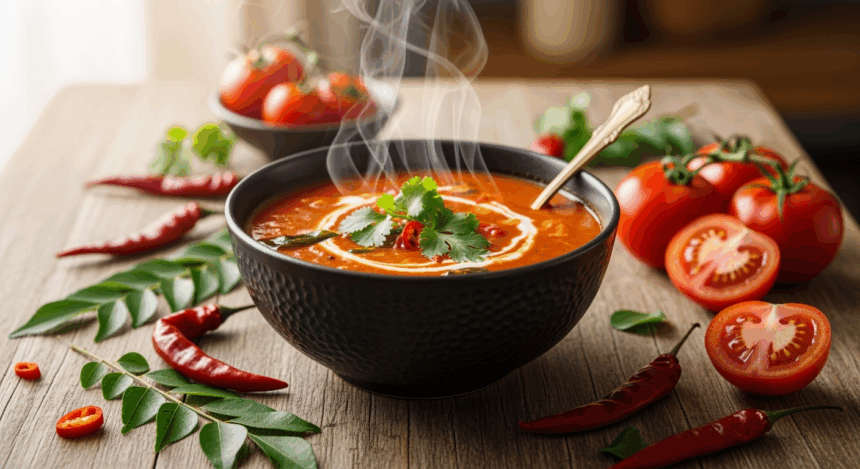Ever had one of those days when your taste buds are screaming for something with a kick, but the thought of wrestling with a complicated recipe makes you want to order takeout? Enter Spicy Tomato Rasam – the South Indian soup that’s like a warm hug with a spicy pinch on the cheek. It’s tangy, it’s aromatic, and it’s exactly what you need when you’re feeling under the weather or just craving something that makes your sinuses clear up dramatically!
Why This Recipe is Awesome
Let me count the ways this Spicy Tomato Rasam will change your life (or at least your dinner plans):
First off, it’s ridiculously quick to make. We’re talking 30 minutes from “I’m hungry” to “this is amazing!” Second, it’s basically a flavor bomb disguised as soup – tangy tomatoes, aromatic spices, and that perfect heat level that makes you sweat just a tiny bit (in a good way). And finally, it’s that rare unicorn of recipes that’s both healthy AND satisfying. I know, mind-blown.
Plus, you’ll feel like you’ve mastered Indian cooking without having to invest in 47 different spices or spend hours grinding pastes. It’s culinary cultural appreciation for the lazy but ambitious.
Ingredients You’ll Need
- 4 medium tomatoes, chopped (the squishier the better – this is where the “meh” tomatoes in your fridge finally become heroes)
- 1 tablespoon tamarind paste or 1 small lemon-sized ball of tamarind pulp (your soup’s tang master)
- 1 tablespoon rasam powder (store-bought is fine, no judgment here)
- 1 teaspoon cumin seeds (whole, not the powder – we’re getting fancy)
- 1 teaspoon black peppercorns, crushed (more if you enjoy breathing fire)
- 4-5 curry leaves (the secret ingredient your non-Indian friends won’t be able to identify)
- 2 cloves garlic, minced (vampire protection AND flavor – multitasking!)
- 1 green chili, slit (optional for the brave souls)
- ½ teaspoon turmeric powder (will stain everything yellow, including your countertop – you’ve been warned)
- 1 tablespoon ghee or oil (ghee makes everything better, but oil works for vegans)
- 1 teaspoon mustard seeds (the little popping guys)
- A pinch of asafoetida/hing (optional but authentic)
- Salt to taste (duh)
- Fresh cilantro for garnish (or not, if you’re one of those people who thinks it tastes like soap)
- 4 cups water (from the tap is fine, no need to import from the Alps)
Step-by-Step Instructions
- Take your tomatoes and give them a rough chop. Don’t stress about perfect knife skills – they’re getting pulverized anyway.
- In a pot, add those tomatoes with 2 cups of water, turmeric, and a pinch of salt. Let it boil until the tomatoes break down and start looking sad (about 10 minutes). Think “tomato mush” – that’s your goal.
- While that’s happening, if using tamarind pulp, soak it in warm water for 5 minutes, then squeeze out the juice and discard the pulp. If using paste, just dilute it with a little warm water. Set aside this tangy goodness.
- Once your tomatoes have surrendered to the heat, mash them a bit with a spoon (very therapeutic after a long day). Add the tamarind juice/paste, rasam powder, crushed black pepper, and 2 more cups of water. Let it simmer for about 10 minutes until the flavors make friends with each other.
- Now for the tadka (the flavor explosion part): In a small pan, heat the ghee or oil. Add mustard seeds and wait for the satisfying pop. This is non-negotiable – no popping means not hot enough!
- Once they’re dancing, add cumin seeds, curry leaves (stand back, they might splatter), minced garlic, green chili if using, and a pinch of asafoetida. Let it sizzle for 30 seconds until fragrant enough to make your neighbors jealous.
- Pour this aromatic oil mixture into your simmering rasam. The sizzle when it hits the liquid is the sound of culinary success.
- Give it one final boil, taste for salt, and turn off the heat. Sprinkle fresh cilantro on top if you’re into that.
Common Mistakes to Avoid
Let’s talk about how not to botch this otherwise foolproof recipe:
Over-boiling the rasam. This isn’t some thick Western soup that needs to reduce for hours. Once it’s boiled after adding the tadka, you’re done. Continuing the boil will make the flavors bitter and you’ll lose all those aromatic elements faster than my motivation to exercise.
Skimping on the tadka. That final tempering with the spices isn’t optional—it’s where 50% of the flavor comes from. Skipping it is like watching a movie without the ending.
Being stingy with black pepper. Rasam literally translates to “essence” or “juice,” but its identity is tied to that peppery kick. Don’t be shy with it unless your spice tolerance is at “mild salsa makes me sweat” levels.
Covering the pot while cooking. Rasam needs to breathe! Keeping it covered will make it cloudy and change the flavor profile. Let it live its best uncovered life.
Alternatives & Substitutions
No rasam powder? No problem. Mix 1 teaspoon coriander powder, ½ teaspoon cumin powder, ¼ teaspoon black pepper, a pinch of red chili powder, and a tiny pinch of fenugreek powder. It’s not traditional, but it’ll do in a pinch (pun fully intended).
Can’t find tamarind? Lemon juice works as a substitute. Start with 2 tablespoons and adjust based on your tang preference.
No curry leaves? This one hurts my soul a little, but you can use a bay leaf plus a tiny bit of lime zest. It’s not the same, but it adds complexity.
Want to beef it up (figuratively)? Add cooked lentils or small cubes of tofu for protein. For a heartier meal, serve the rasam with rice or crusty bread for dipping.
Make it extra: Add a diced carrot or handful of spinach while simmering for extra nutrients. Your mom would approve.
FAQ (Frequently Asked Questions)
Is rasam supposed to be watery?
Yes! Unlike Western soups that are often thick and creamy, authentic rasam has a broth-like consistency. It’s meant to be sipped or poured over rice, not eaten with a fork (which would be hilarious to attempt).
Can I make this ahead of time?
Absolutely! Rasam actually tastes better the next day when the flavors have had time to get cozy with each other. Just reheat gently and maybe add a fresh tadka if you’re feeling fancy.
My rasam tastes too sour. Did I mess up?
Nah, you probably just went overboard with the tamarind. Add a tiny pinch of sugar or jaggery to balance it out. Crisis averted!
Can I freeze rasam?
You can, but should you? The texture changes a bit upon thawing, and the fresh aromatics lose their punch. If you must, freeze the base without the tadka, then add fresh tadka when reheating.
Is rasam really good for colds like my Indian friend claims?
IMO, absolutely! The combination of pepper, garlic, and spices is basically nature’s decongestant. Plus, the warm liquid is soothing for sore throats. It won’t cure your cold, but it’ll make you feel human again.
How spicy is this really?
That’s entirely in your hands! The recipe as written is medium spicy—enough to make you notice but not enough to make you cry. Adjust the black pepper and green chili to match your spice tolerance (or to impress someone you’re cooking for).
Final Thoughts
Congratulations! You’ve just made a soup that’s been perfected over centuries in South Indian kitchens. Take a moment to appreciate that you created something with the perfect balance of tangy, spicy, and aromatic—all without breaking a sweat (unless you went heavy on the pepper).
Rasam is more than just soup; it’s comfort in a bowl. Whether you’re fighting off a cold, looking for a light meal, or just wanting to impress friends with your international culinary skills, this recipe has your back.
Now go pour yourself a bowl, maybe add some rice if you’re feeling traditional, and enjoy the warmth spreading through your body. And remember—slurping is not just acceptable with rasam, it’s practically mandatory. Bon appétit… or as they say in South India, “Rasam saapidungo!” (That’s “enjoy your rasam” for those who don’t speak Tamil.)



